Matthew Tostevin
It is said that this is where the world began—and perhaps where it will end.
The true epicenter of the war in the Holy Land is not the devastated Gaza Strip, under Israeli assault since Hamas' bloody raid last October sparked the region's deadliest conflict in decades. It is a few dozen miles away in Jerusalem, at the holiest and most fiercely contested hilltop on Earth. The war has increased religious tensions and given new impetus to a group of Jews and their evangelical Christian allies who are set on rebuilding an ancient temple where millennium-old Islamic shrines now stand—a suggestion that arouses the horror not only of Palestinians and Muslims worldwide, but of many Jews in Israel and around the globe as well as that of would-be Middle East peacemakers.
Third Temple advocates have been preparing for the day when the temple can be rebuilt, complete with rabbinically-certified red cows shipped from Texas for use in sacrificial purification rituals. The architectural designs are all ready, along the lines of the detailed Biblical descriptions. Robes have been woven and utensils assembled to Biblical specifications for ceremonies at the planned temple.
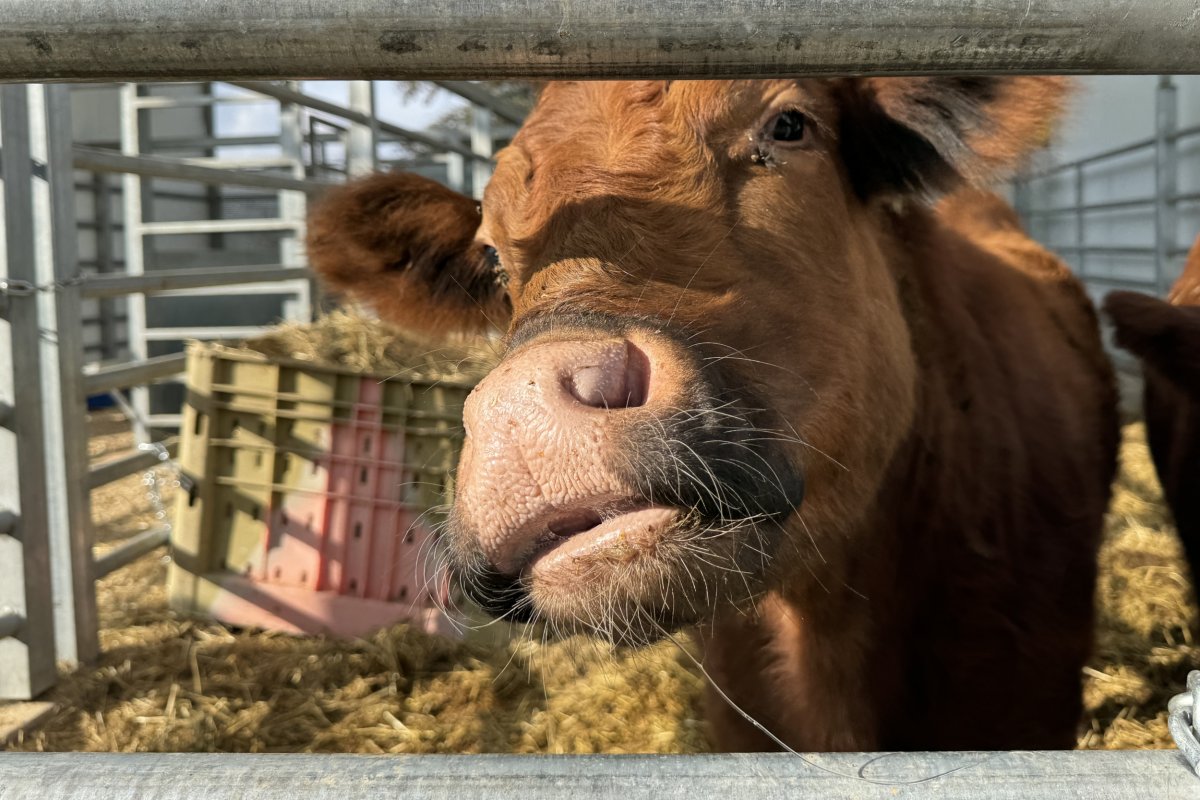 Red heifer at the Israeli settlement of Shiloh in the occupied West Bank. Five of the unblemished red cows were flown from Texas for possible use in eventual sacrificial rites associated with building a new... MoreMATTHEW TOSTEVIN
Red heifer at the Israeli settlement of Shiloh in the occupied West Bank. Five of the unblemished red cows were flown from Texas for possible use in eventual sacrificial rites associated with building a new... MoreMATTHEW TOSTEVINMessianic Jewish supporters believe the rebuilding of the temple, rather than being divisive, would fulfil Biblical prophecy to bring an era of peace with the temple as "a house of prayer for all nations." Christian backers, meanwhile, believe it would be an important step towards the Second Coming of Jesus and an apocalyptic last battle with the Antichrist.
"Our holy warriors who are fighting in Gaza are actually fighting for the building of the Temple," one Jewish prayer leader pronounced recently on a controversial visit to the believed site of two previous Jewish temples in Jerusalem.
Standing before the Dome of the Rock, the gleaming Islamic shrine that has sat for more than 1,300 years on the same contested spot, Marina Sokol, an Israeli mother whose son was killed fighting Hamas in Gaza, proclaimed: "The war we are waging is a war for the Temple Mount."
In their war to destroy Israel and replace it with an Islamic state, Hamas leaders also readily draw on the symbolism of Jerusalem and the Temple Mount, known to Muslims as Haram al-Sharif (the Noble Sanctuary). It is the third holiest site in Islam with its Al-Aqsa Mosque as well as being the holiest site in Judaism. "This round of conflict is being waged by the resistance under the name 'Al-Aqsa Flood.' It is not for the sake of Gaza or the West Bank, but rather for the sake of Jerusalem and Al-Aqsa," Hamas spokesperson Bassem Naim told Newsweek.
Hamas killed about 1,200 Israelis and kidnapped more than 200 in its unprecedented October 7 attack, according to Israeli figures. Israel's ensuing offensive against Hamas has so far killed over 32,000 Palestinians in Gaza, according to Hamas authorities there. They do not say how many of those were combatants. Israel said at least 13,000 of them were.
Flood
Hamas has long put the fight against "Judaization" of holy sites high on its list of reasons for seeking to destroy Israel.
During the ongoing holy month of Ramadan, Hamas leaders again urged Palestinians to rally to the 36-acre holy site, scene of frequent confrontations in the past, and spark for wider violence. Israel has restricted the number of worshippers in the name of security concerns, drawing complaints from Palestinians of unfair treatment and of breaking longstanding agreements.
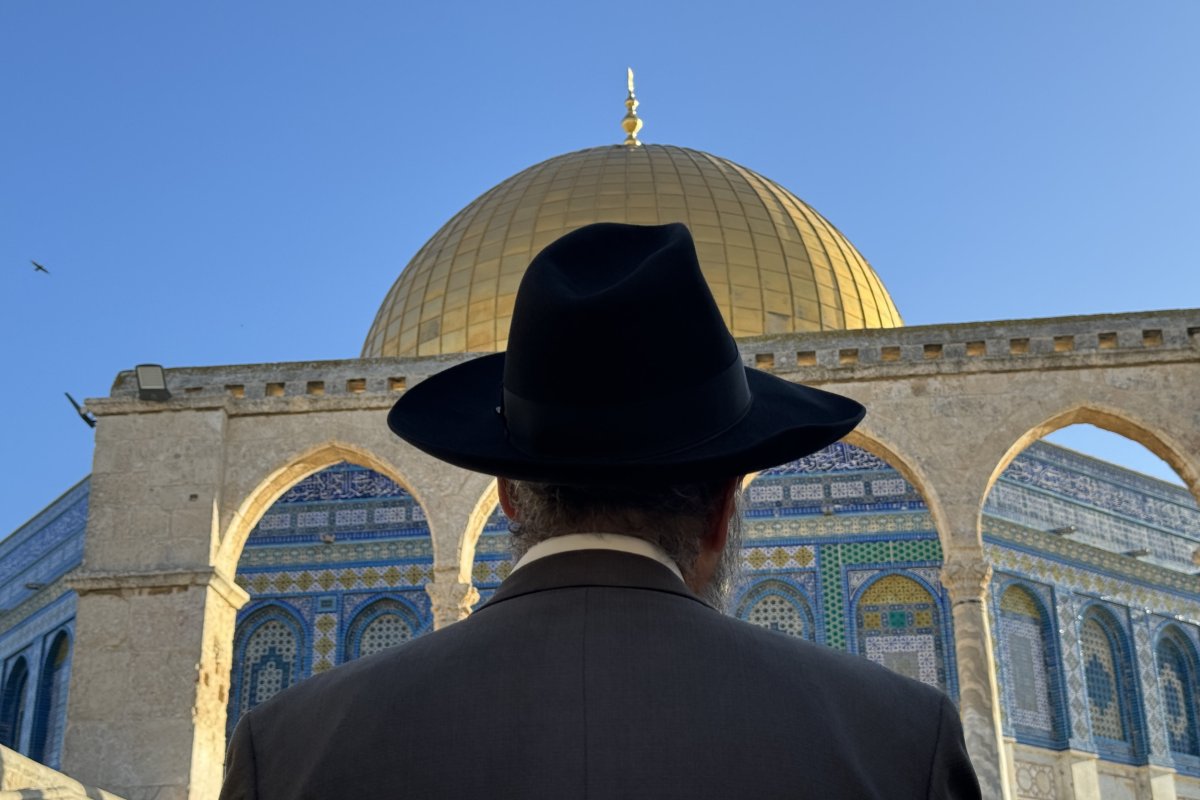 A religious Jewish man looks at the Dome of the Rock, an Islamic shrine in Jerusalem on December 3, 2023. Groups who believe in building a Third Temple say the Dome of the Rock stands... MoreMATTHEW TOSTEVIN
A religious Jewish man looks at the Dome of the Rock, an Islamic shrine in Jerusalem on December 3, 2023. Groups who believe in building a Third Temple say the Dome of the Rock stands... MoreMATTHEW TOSTEVINIsrael's government has set its three war aims in Gaza as destroying Hamas, bringing home the hostages that remain and ensuring that the territory can no longer pose a threat—aims that have widespread support among Israeli Jews. But the hope that the conflict might be a step to the rebuilding of the temple also resonates for Third Temple advocates, who form part of a fringe that has gained strength under the right-wing government of Prime Minister Benjamin Netanyahu.
"The Holy Temple - Now, More than Ever!" said a social media post from the Temple Institute, one of the leading groups seeking to promote interest in rebuilding the temple.
"We're all looking forward to the day after Israel's defeat of all our enemies. Building the Holy Temple, 'a house of prayer for all nations,' (Isaiah 56:7) is the only peace plan that can & will succeed!" said the institute, which in the past was reported to have received some state funding, but says it no longer does.
"The Muslims correctly understand the historical and religious significance of the Temple Mount for the Jewish people and therefore focus their incitement on the Temple Mount," Yitzchak Reuven, director of the Temple Institute's international department, told Newsweek. "In effect, the war in Gaza is very much a war over the Temple Mount."
An Israeli government spokesperson acknowledged Newsweek's questions but did not respond by time of publication.
For Palestinians, the growing Jewish religious activity at the site is already a step towards cataclysm.
"These are the seeds of conflict and the seeds of the type of fire that could burn the entire Middle East," Palestinian academic Adnan Joulani told Newsweek. "This is the most dangerous plot of land to play with."
The Palestinian Authority, which runs parts of the Israeli-occupied West Bank and seeks a state alongside Israel, did not respond to a request for comment.
According to Jewish tradition, the place known as Mount Moriah is where the world was created. This was where Abraham offered his son as a sacrifice. For Jews and Christians that son was Isaac, whereas most Muslim sources say it was Ishmael. This was where King Solomon built the First Temple, destroyed by the Babylonians in 586 BC. It's thought the Second Temple was built 70 years later—the temple from which Christians believe Jesus drove out the moneychangers. That temple was destroyed by the Romans in 70 AD.
For Muslims, the site is where Muhammad made a miraculous night journey from Mecca before ascending to heaven. Muhammad and his early followers turned here for prayer before they turned to Mecca. The Dome of the Rock was built little over 50 years after Muhammad's death in 632 AD. In the Middle Ages, some Muslims, Jews, and Christians believed the gold-domed and elaborately tiled structure actually was Solomon's Temple.
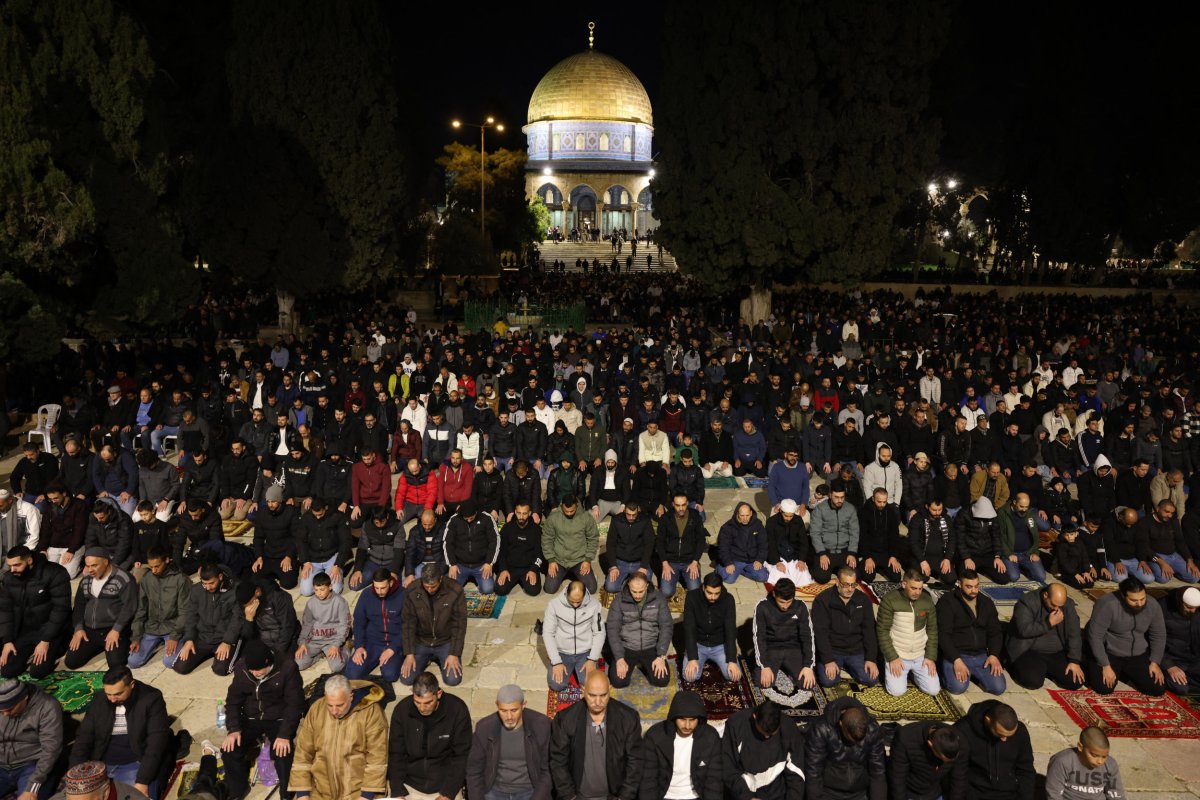 Palestinian Muslims pray outside the Dome of the Rock in Jerusalem's Al-Aqsa Mosque compound on March 11, 2024. The site is the third holiest in Islam as well as the holiest for Jews, who know... MoreAHMAD GHARABLI / AFP
Palestinian Muslims pray outside the Dome of the Rock in Jerusalem's Al-Aqsa Mosque compound on March 11, 2024. The site is the third holiest in Islam as well as the holiest for Jews, who know... MoreAHMAD GHARABLI / AFPOutliers
A call to rebuild the temple is part of the daily prayers of religious Jews. But those actively seeking to make it happen are outliers within a religious nationalist movement that sees a God-given right over all the land from the River Jordan to the Mediterranean Sea—a belief which has helped drive settlement of the occupied West Bank since the 1967 Middle East War. Still a tiny minority, Third Temple advocates gained momentum as Israeli politics swung towards the religious right under Netanyahu.
"The Third Temple movement have a lot of power. They are in the government, they are having a lot of support, something they never had before," said Yonatan Mizrachi of the Peace Now group, part of a once influential left-wing peace movement that has itself been pushed to the margins, particularly since the Hamas attack. "Twenty years ago, even the settlers tried to avoid dealing with the Temple Mount/Haram al-Sharif. There were only a few people, a few dozen, and today we're talking about a movement," he told Newsweek. "A very loud movement, but still a minority."
Outside Israel, the movement has little traction.
"First of all, 90 percent of American Jews have no concept of a Third Temple in any traditional way," said Rabbi Asher Lopatin, director of community relations at the Jewish Federation of Greater Ann Arbor, Michigan. "The other 10 percent who are Orthodox or Traditional are almost entirely of the opinion that the Third Temple will be rebuilt only after the Mashiach (Messiah) comes and there is world peace," he told Newsweek. "Ultra-Orthodox Jews believe that only God will build the Third Temple."
The Third Temple activists in Israel distance themselves from the most extreme radicals, such as the underground group whose members were arrested in 1984 with an alleged plan to blow up the Muslim sites. Many Third Temple activists assert that ultimately Muslims themselves will ask for the temple to be built in fulfilment of divine will.
 Third Temple activist Melissa Jane Kronfeld in Jerusalem on December 3, 2023. Advocates of rebuilding the temple where Muslim shrines now stand are a small minority.MATTHEW TOSTEVIN
Third Temple activist Melissa Jane Kronfeld in Jerusalem on December 3, 2023. Advocates of rebuilding the temple where Muslim shrines now stand are a small minority.MATTHEW TOSTEVIN"Oh, we definitely need to get rid of the Dome of the Rock," said Melissa Jane Kronfeld, who came to Israel from New York and is as a vocal supporter of the movement. "I actually think it should be moved and preserved into a beautiful museum somewhere," she said. "It's not part of the plan," she told Newsweek. "God laid out exactly what the temple is supposed to be."
She and others are not fazed by the challenges over removing one of the world's most iconic structures. In addition to being an architectural emblem of Jerusalem, the Dome of the Rock is a symbol of the state long sought by Palestinians with Jerusalem as its capital. Israel also claims Jerusalem as its capital. The Dome of the Rock is part of the same compound as the Al-Aqsa Mosque, which is not itself on the land where the temples are thought to have stood.
"We will defend the mosque to the very end," said Abu Ibrahim, a retired taxi driver, on the stone plaza outside the mosque. He took a bullet through the leg during riots in 1990 when Palestinians feared a takeover by Third Temple activists. At least 17 Palestinians were killed at the time. "It is an Islamic place and not a Jewish one," he said. "They have no right to pray here."
Prayers
The struggle over prayer rights is happening right now.
Every morning that visits by non-Muslims are allowed, groups of religious Jews gather at the one gate through which they are permitted to visit. Every morning, an Israeli police officer tells them that they are not allowed to pray on the Temple Mount. Every morning, they go up under police escort and pray there, reciting from their mobile phones.
"Those who say prayers aren't happening here aren't the ones who are coming up with us," said Kronfeld, whose group, High On The Har, encourages visitors.
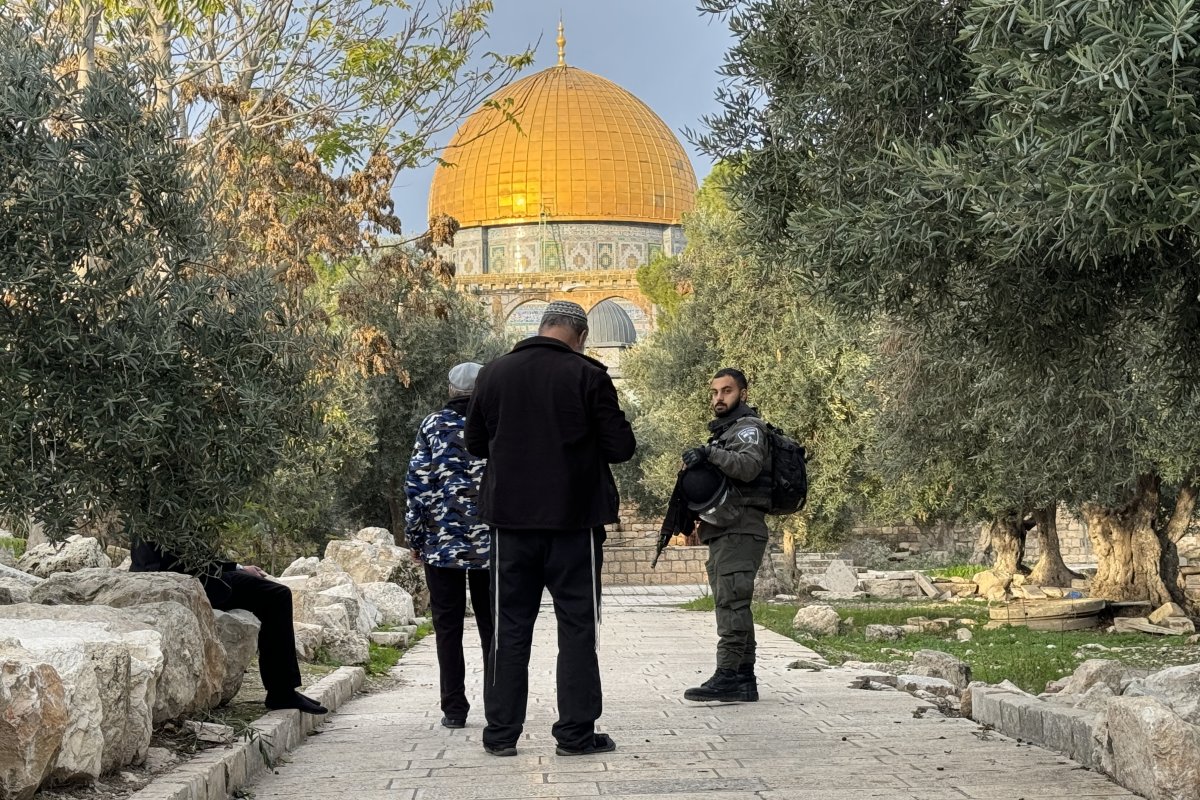 Jewish worshippers pray under police guard at the Temple Mount, which Muslims know as Haram al-Sharif (The Noble Sanctuary). The holy site is one of the most contested on Earth.MATTHEW TOSTEVIN
Jewish worshippers pray under police guard at the Temple Mount, which Muslims know as Haram al-Sharif (The Noble Sanctuary). The holy site is one of the most contested on Earth.MATTHEW TOSTEVINThe legal situation for prayers is complicated. After Israel captured the site in the 1967 war, it ignored the suggestion of the army's then-chief rabbi to blow up the Dome of the Rock and clear the way for the Third Temple. Instead, the government chose to retain a "status quo" with administration under an Islamic Waqf that bans prayer by anyone except Muslims. Although Israel's Supreme Court has ruled that Jews have the right to pray there, it also said that the right can be limited in the public interest—as in, to avoid inflaming the situation. Visits by non-Muslims are not allowed on Fridays: the day of the main Muslim prayers, or on the Jewish Sabbath. They are also curtailed during Ramadan and other Muslim holidays.
The status quo has come under strain as Israeli politics has shifted. Hardline Security Minister Itamar Ben-Gvir made the point of proclaiming Israeli ownership during controversial visits last year, drawing furious responses from Palestinian groups, including Hamas. The security ministry did not respond to a Newsweek request for comment.
Palestinians complain that their own prayer rights are being restricted by the Israelis, particularly since the war in Gaza.
"They are changing the status quo and creating a new agenda," Palestinian political scientist Mahdi Abdul Hadi, a member of the Waqf council, told Newsweek.
Trouble at the site quickly fires up the region. It helped to trigger the second Palestinian Intifada in 2000 as the uprising derailed peace talks. In 2021, Israeli police stormed the compound after stone-throwing protests over Ramadan prayer restrictions. The result: 11 days of fighting between Hamas and Israel, and an inexorable step towards the latest conflict.
"This is a symbol for us. We have a holy duty to save it," said Palestinian shoe seller Sami Taim, who at 24 is too young to be allowed inside the compound most of the time by the Israeli border police who patrol the Old City. "We will never give up," he told Newsweek.
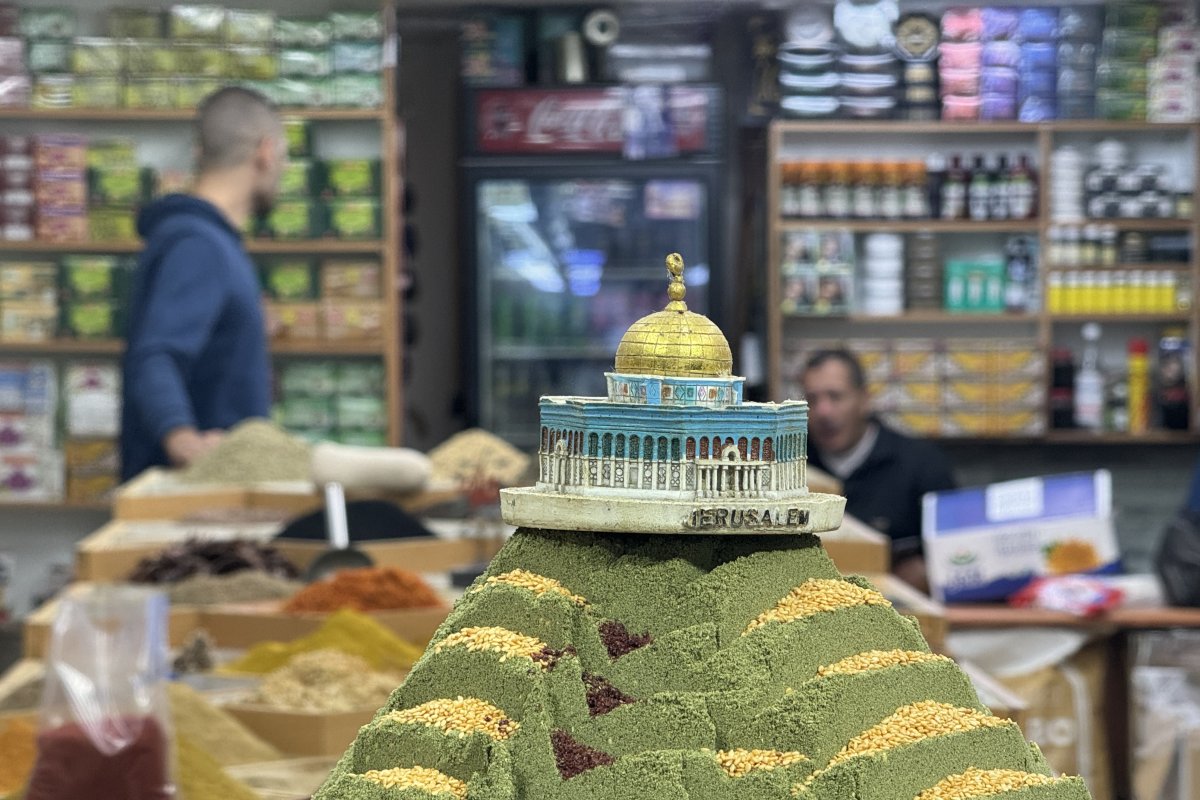 A model of the Dome of the Rock Islamic shrine on top of a pile of spices in a Jerusalem market. The shrine and the Al-Aqsa Mosque compound where it stands are not only holy... MoreMATTHEW TOSTEVIN
A model of the Dome of the Rock Islamic shrine on top of a pile of spices in a Jerusalem market. The shrine and the Al-Aqsa Mosque compound where it stands are not only holy... MoreMATTHEW TOSTEVINWhile Israeli Jews agree on the holiness of the site, there is no unified view of what should be done there in a society that has its own deep divisions among the religious; between the religious and secular; between left and right; and between Israelis whose ancestors immigrated from different parts of the world.
"The fact that our enemies recognise the importance of this place and we don't is literally the tragedy of a generation," lamented one young prayer leader during a prayer at the site one Sunday for a dozen or so people, some of whom visit several times a day.
By contrast, Sephardic Chief Rabbi Yitzhak Yosef has said that any Jew who even visits the site is sinning—not to even mention seeking to build a Third Temple. He sent a stern letter to Ben-Gvir after his visit.
Even on the religious right, some are wary of the Third Temple movement in fear that it could undermine the immediate push for prayer rights at the holy site.
"I pray every single day for a Third Temple, but there's a difference in this time and in these generations from the practical step that we want," said Yishai Fleisher, international spokesperson for the Jewish community of Hebron, scene of frequent confrontations between Jewish settlers and Palestinians in the West Bank.
"Nobody is offering up a bill to build a Third Temple, but we do want it to be open on the Sabbath," he told Newsweek.
Israeli Divisions
A poll in 2022 found that 50 percent of Israeli Jews favored allowing Jewish prayers at the Temple Mount, with 40 percent against. But only 12 percent saw prayer at the site as a religious commandment: for the rest, it was to demonstrate sovereignty. Among secular Jews, 39 percent opposed allowing prayers because of the potential reaction from the Muslim world.
Strains are evident at the site itself. Impatient police guards chivvy the Jewish worshippers along. One secular officer draws a severe rebuke from Kronfeld when he lights up a cigarette and flicks ash on the ancient stones.
The relationship between Israeli governments and the Third Temple movement has also been equivocal—at times dismissive, but with supporters also courted for political advantage. In 2013, Israel's Army Radio revealed that the Temple Institute had been getting state funding for its cultural and educational work, although it now says it gets no government help and relies on donations and sales from its museum and gift shop.
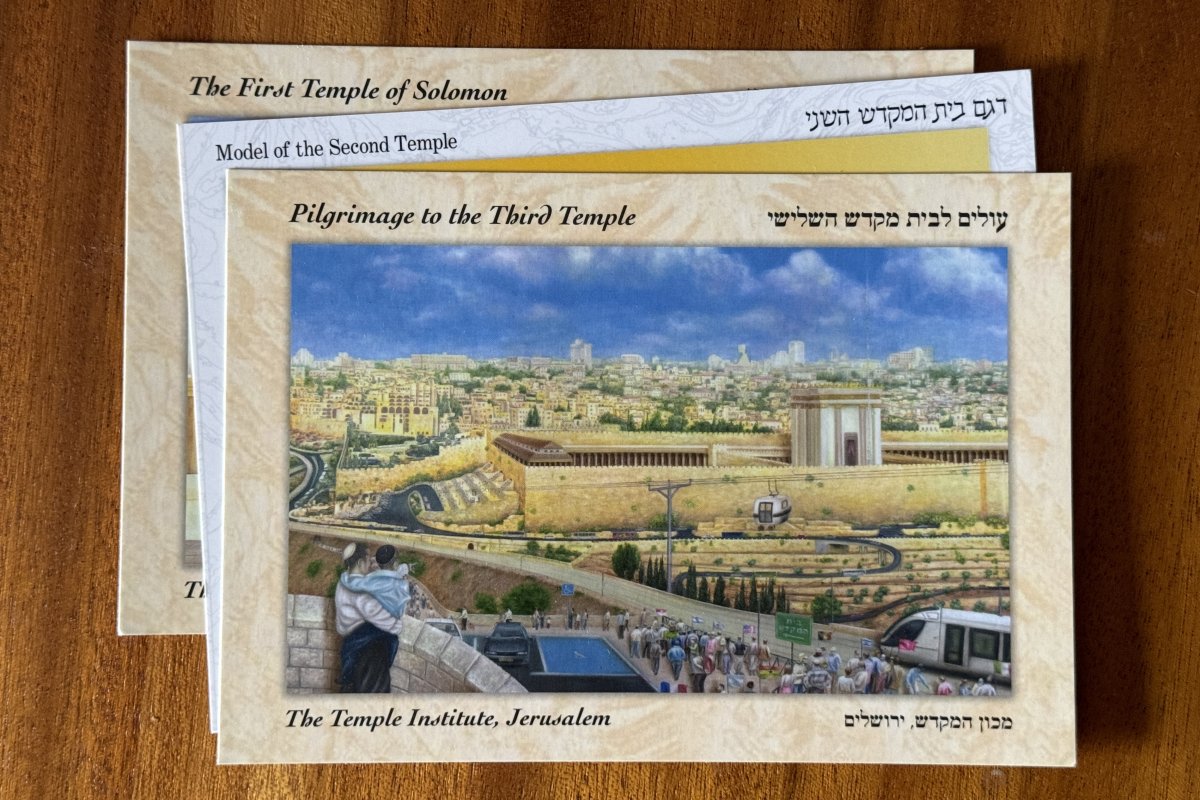 Postcards sold by the Temple Institute in Jerusalem give an artist's impression of the Third Temple. War in Gaza has given new impetus to a small group of Jews seeking to build a temple where... MoreMATTHEW TOSTEVIN
Postcards sold by the Temple Institute in Jerusalem give an artist's impression of the Third Temple. War in Gaza has given new impetus to a small group of Jews seeking to build a temple where... MoreMATTHEW TOSTEVINIn the Old City's Jewish Quarter, the institute's displays feature robes made using Biblical-era dyes and yarn that have been prepared for the eventual ceremonies at the temple. There is an altar and a solid gold menorah. The gift shop sells postcards with an artist's impression of the Jerusalem of the future, with pilgrims heading to a Third Temple that has replaced the Dome of the Rock.
"Most physical preparations have already been made," the institute's Reuven said. "The Temple vessels have been recreated. The Temple Institute has also recreated the garments of the high priest as well as the other priests. A modest scale-sized altar has also been made, which can easily be transported to its intended location on the Temple Mount."
"While we make every effort in our limited ability to kindle interest in building the temple, the rebuilding of the temple is not a Temple Institute project. Such a monumental effort would need to be based on broad support from the people of Israel and members of the international community," he added.
Evangelical Link
Non-Jews are among the most fervent supporters of the Third Temple: they are Christians who anticipate the Second Coming of Jesus before a Day of Judgment—a view of the End Times that is, in fact, broadly shared with Muslims.
One of those believers is Byron Stinson, a soft-spoken Texan and self-proclaimed Judeo-Christian who splits his time between the U.S. and Israel and is dedicated to helping "the fathers of the faith" build a new temple.
"This is God's plan," he told Newsweek by phone from his truck rolling across Texas. "It's being lived out right now right in front of our eyes."
Stinson helped secure five red heifers in Texas and ship them over in 2022. The cattle are needed for a purifying ceremony for the temple (sacrificial knives are on display at the Temple Institute). Not any red cows will do. They must be "without defect or blemish" (Numbers 19) and must never have worked. It was not cheap getting them to Israel: they had to be transported as pets aboard an American Airlines Boeing 777.
Once the ceremony has been performed and the ashes of a red heifer are mixed with herbs and the waters of Jerusalem's Gihon Spring, the purifying mix can last hundreds of years, Stinson said. But he reckoned 20 or 30 years would be enough for the temple.
"When we see the temple there, I'm expecting repentance, and then joy, and then celebration of the power of God, because he is showing the world that he is God," Stinson said. "It's not like it'll happen in one day, in my opinion, but it will happen."
Holy Cows
 A red heifer looks from its pen at Shiloh in the West Bank on December 7, 2023. The red cows were brought from Texas for rites associated with the rebuilding of the Jewish temple in... MoreMATTHEW TOSTEVIN
A red heifer looks from its pen at Shiloh in the West Bank on December 7, 2023. The red cows were brought from Texas for rites associated with the rebuilding of the Jewish temple in... MoreMATTHEW TOSTEVINFor now, home for the cows is a metal shed more than 7,000 miles from their Texas birthplace at the Israeli settlement of Shiloh in the West Bank. They look out from their straw-lined pen with gentle eyes, offering up muzzles in the hope of petting or treats. Rabbis inspect them occasionally to ensure they have no white hairs.
There is symbolism to having the red heifers in Shiloh. According to believers, this is where the tabernacle—a portable forerunner of the temple—stood for more than 300 years. In the Bible, Shiloh was Israel's first capital. Now, it is at the heart of the Israeli-Palestinian conflict and violence in the West Bank has intensified along with the Gaza war.
Shiloh is one of the settlements that have long been seen by Palestinians and negotiators as among the biggest obstacles to a peace agreement and as illegal under international law—a view challenged by Israel. Those settlements are now home to more than half a million people. Netanyahu, a longstanding opponent of a Palestinian state alongside Israel, planted an olive tree at Shiloh in 2019. A plaque says the tree he planted "symbolizes our hold on the ground of our homeland." Olive trees can live for thousands of years.
Long Fight
Third Temple advocates point out to those who question their ambitions that the idea of Israel itself is not much more than a century old and few believed in it when Theodor Herzl founded his movement to promote Zionism in the 19th century.
The religious dimension to the conflict and the vision of a multi-generational struggle—on top of nationalism, claims to land and the basic survival sought by all parties—further confound would-be peacemakers such as the successive U.S. administrations that have called for a two-state solution with Israelis and Palestinians splitting the land.
"Westerners have difficulties accepting this type of prism to conflict," said Efraim Inbar, president of the Jerusalem Institute for Strategy and Security. "It's a misconception to believe that the Americans will suggest some kind of wonderful agreement and pour money on us, on them. It's nonsense."
Prospects for such an agreement appear to have receded further during the Gaza war, with Netanyahu categorically rejecting U.S. President Joe Biden's calls to back one. Support for a two-state solution had been flagging even before October 7, but a Gallup poll at the end of 2023 said it stood at 25 percent in Israel compared to 61 percent in 2012. Support among the Palestinians has also tumbled from a decade ago, although a survey in March showed that it had nearly doubled in Gaza to 62 percent since December while still only 34 percent in the West Bank.
The absence of a deal for a Palestinian state suits Third Temple advocates. Some activists believe the trauma of the Hamas attack on October 7 and the war that followed will push Israelis further towards a stronger claim to the holy sites—if only from security concerns rather than from religious convictions.
Although the war has prompted accusations from left wingers that Israel's rightward tilt and neglect of peacemaking helped to bring the conflict about, it was far right and religious parties that made notable gains in recent municipal elections in Jerusalem, the first vote since the war.
Third Temple activists sense new momentum.
"I'm always told the Third Temple is going to destablize the Middle East and it's going to start a war. Well, I'm pretty sure the war is already here and the Middle East is pretty destabilized," said Kronfeld. "I like to think about it the other way. What if the Third Temple is the answer? What if it's what brings the peace and stabilizes the region?"
No comments:
Post a Comment